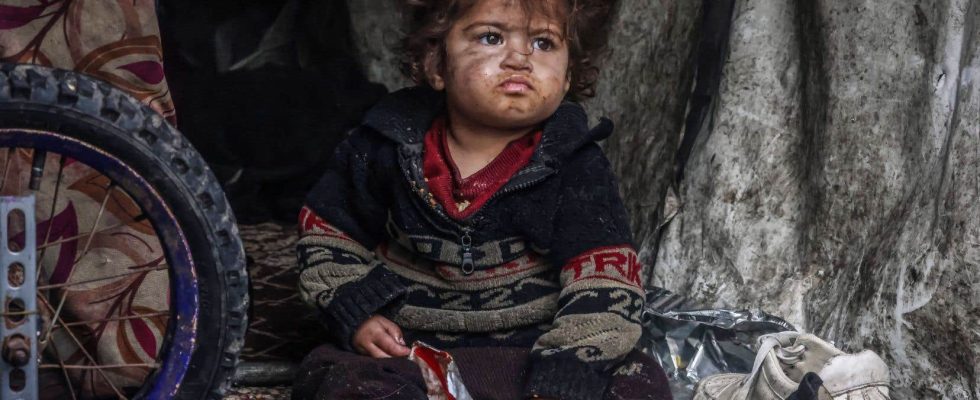A first boat loaded with food is slowly progressing towards the Gaza Strip on Thursday as efforts accelerate to try to deliver more humanitarian aid to the besieged Palestinian territory threatened with famine after more than five months of war between Israel. and Hamas.
The distribution of aid in Gaza, particularly in the North where the situation is critical for 300,000 people, is dangerous as the fasting month of Ramadan began this week.
The population scans the sky daily hoping to recover food during parachute operations, but the quantities dropped are limited.
“Everyone is scrambling violently to get a box for their children, to collect a can of tuna or beans,” Mokhles al-Masry told AFP, a bag of flour on his shoulders in Beit Lahia. “All the people are hungry and exhausted.”
In the south, in Rafah, AFPTV images on Thursday showed a crowd rushing to pick up a few bags of flour that had fallen from a truck delivering aid.
With no new truce in sight after more than five months of war between Israel and Hamas, Israeli bombings continue without respite and have left 69 dead in the last 24 hours, according to the Palestinian Islamist movement’s Ministry of Health.
The Hamas government on Thursday counted more than 40 airstrikes on Rafah and the neighboring town of Khan Younes (south), as well as on Nousseirat, Jabaliya and Beit Hanoun, in the north. Intense artillery fire also targeted several localities.
On Wednesday, the UN agency for Palestinian refugees (UNRWA) denounced a strike on one of its warehouses in Rafah, killing at least one of its employees. The Hamas Ministry of Health cited a death toll of four, including Mohammad Abou Hasna, presented as an official responsible for the security of the warehouse. But for the Israeli army, it was a Hamas cadre “eliminated” in a targeted strike.
The ministry also reported seven deaths and many injured by Israeli fire during an aid distribution near Gaza City. Questioned by AFP, the army did not immediately comment.
Earth and sea
Aid by land only enters sparsely in the Gaza Strip, subject to the control of Israel which has imposed a siege since the start of the war triggered by an unprecedented attack by Hamas on Israeli soil on October 7.
The attack resulted in the deaths of at least 1,160 people in Israel, most of them civilians, according to an AFP count based on official Israeli sources. According to Israel, 130 hostages are still in Gaza, 32 of whom are believed to have died, out of around 250 people kidnapped that day.
In retaliation, Israel promised to “annihilate” the Islamist movement, in power in Gaza since 2007, and launched an offensive which left 31,341 dead, mostly civilians, according to the report released Thursday by the Ministry of Health.
In addition to the airdrops, a maritime corridor was opened on Tuesday between Cyprus and Gaza (around 270 km) to deliver aid with a first ship loaded with 200 tonnes of food. This boat from the Spanish NGO Open Arms, which tows a barge, was Thursday afternoon off the Israeli city of Ashdod, north of Gaza, according to the specialized site Marine Traffic.
Cyprus, at the origin of this maritime corridor, announced that a second boat was ready to leave with a larger cargo.
Four American army boats also left the United States on Tuesday with the equipment necessary to build a pier and a quay in Gaza to disembark humanitarian aid “within 60 days” , according to American authorities.
“No valid alternative”
But according to the UN, these options cannot replace the land route, a widely shared observation.
“There is no viable alternative to land routes through Egypt and Jordan and Israel’s entry points into Gaza for large-scale aid deliveries,” the United States stressed, Cyprus, the United Arab Emirates, the EU and Qatar in a joint statement.
A meeting is to take place next week in Cyprus for “in-depth discussions on the activation of the (maritime) corridor including American efforts”, they said.
They also judged that opening the Israeli port of Ashdod to humanitarian aid “would constitute a welcome and significant addition” to the system.
Aid by land is mainly delivered from Jordan or Egypt to two Israeli checkpoints in southern Gaza where goods are extensively inspected.
Israeli authorities deny that these controls slow down the entry of aid.
“If the UN wants to see more aid (going) to northern Gaza, it should send more convoys,” Col. Elad Goren, an official in the Defense Ministry’s agency responsible for aid affairs, said Thursday. Palestinian civilians (Cogat).
“Humanitarian Island”
Israeli Prime Minister Benjamin Netanyahu reiterated Thursday his objective of a ground offensive on Rafah, on the closed border with Egypt where, according to the UN, around 1.5 million Palestinians are massed. “We will enter Rafah,” he said, despite concern from the international community, including the United States, Israel’s main ally.
Israel must make the protection of civilians and humanitarian aid in Gaza its “number one” priority, US Secretary of State Antony Blinken said on Wednesday.
The spokesperson for the Israeli army, Daniel Hagari, spoke on Wednesday of the establishment of a “humanitarian island” where the inhabitants of Rafah would be moved before the offensive and where they would have “temporary accommodation, food , water and field hospitals.
Washington is still trying, with Qatar and Egypt, the two other mediator countries, to reach an agreement for a truce of several weeks between Israel and Hamas. During the night, Hamas leader Ismaïl Haniyeh judged that an agreement was still possible, calling on Israel – which refuses a definitive ceasefire and instead pleads for a pause in the fighting while demanding proof of life of his hostages — “to abandon his intransigence”.
